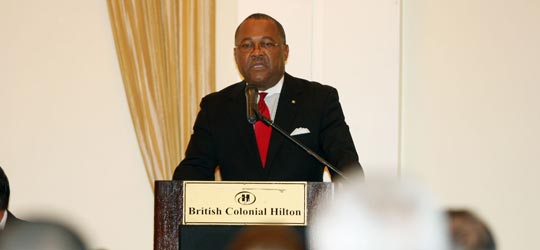
Nassau – The The Hon. Neko C. Grant, Minister of Public Works and Transport described the signing of a contract and loan agreement for the construction of the JFK Airport Gateway as a “significant” one for the Trust Agenda Infrastructure Crusade.
The Government of The Bahamas signed a contract for the construction of the Airport Gateway four-lane highway with China Construction Company and a $58 million loan with China Export Import Bank on September 30. Among those participating in the ceremony was Prime Minister the Rt. Hon. Hubert Ingraham, the Hon. Zhivargo Laing, Minister of State for Finance, the Hon. Earl Deveaux, Minister of the Environment and Senator the Hon. Vincent Vanderpool-Wallace.
Also witnessing the signing of agreements were Members of Parliament, Senators, Anita Bernard, secretary to the cabinet and Ehurd Cunningham, acting financial secretary and senior government officials. In his address Mr. Grant outlined details of the activities in the project schedule that is divided into six sections.
They include a new US Terminal access to Coral Harbour Road, water and electrical utility works, east and west bound carriageways and ancillary works.
“We recognise that JFK Drive is a major thoroughfare providing direct access to the island’s main port of entry (the Lynden Pindling International Airport) to industrial plants at Clifton Pier and to the residential communities of western New Providence. Bearing this in mind we are committed to the execution of this project in a manner that would create minimal discomfort and inconvenience to members of the public who may utilise this route.”
Minister Grant said the pubic would be informed at every stage of the progress of the project. He asked drivers to exercise caution when approaching and navigating JFK Drive.
In his remarks Minister Deveaux said the roadway directly affects 110 acres of land – including wetlands, Lakes Killarney and Cunningham, coppice and pine forests, and hills. It is his Ministry’s goal to clearly identify the risks and impacts and ensure that the net benefit exceeds the impact that will result in the wake of the project’s footprint.
Among other things, Mr. Deveaux said an Environmental Impact Assessment (EIA) highlighted the importance of the wetlands, trees, and hills in relation to the total footprint of the project; drainage, runoff, storm water and the likely impact on the surroundings lakes and groundwater.
Furthermore, Mr. Deveaux said the EIA noted the preservation and conservation of natural habitat, the value of and the extent to which wildlife habitats are affected; and the accessibility of utilities for corporations.
“The new roadway will be raised above the existing roadway which is currently only just at the level of the water table’s high mark in certain areas,” said Mr. Deveaux.
“This will eliminate the problem of flooding, prolong the life of the road, and reduce the cost of maintenance for the busy thoroughfare.
“Storm water and drainage control techniques such as crowning, in-sloping, out-sloping, swales and drainage wells will ensure adequate drainage and minimise the erosion and sedimentation commonly associated with flatter roads.”
Mr. Deveaux said invasive casuarinas will also be removed and the project area will be replanted with indigenous vegetation that will provide additional habitats and remarkably improve the scenery along the entire route.
“The extensive landscaping and tree planting in the median and along the sides of the artery will greatly enhance the overall environmental mitigation of the project’s impact,” he added.
By Kathryn Campbell
Bahamas Information Services



